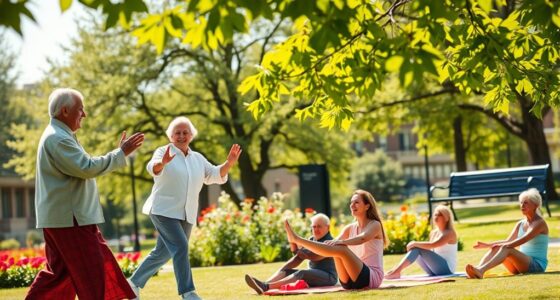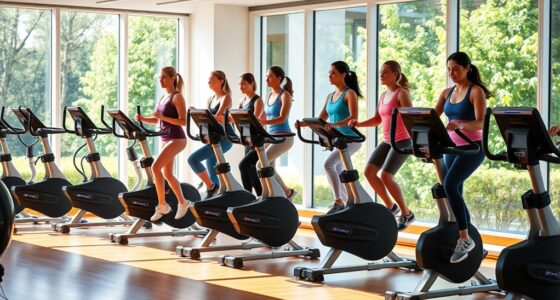Indoor walking exercises can greatly boost your mobility and energy levels. By engaging in warm-ups like marching in place and incorporating knee raises during your workout, you’ll enhance core strength and stability. Don’t forget to include fun movements like side steps with arm actions to keep your heart rate up. Cooling down with stretches guarantees recovery and flexibility. Stay motivated by celebrating your progress and setting achievable goals. There’s even more to explore for a fulfilling exercise routine!
Key Takeaways
- Engage in warm-up exercises like marching in place to enhance core stability and prepare the body for walking activities.
- Incorporate knee ups and side steps during walking to improve balance, coordination, and cardiovascular health.
- Utilize arm movements, such as bicep curls, to strengthen the upper body while walking, boosting overall energy levels.
- Practice cool down techniques with stretching and deep breathing to promote recovery and reduce stiffness after exercise.
- Set achievable walking goals and celebrate small wins to maintain motivation and a positive mindset throughout the routine.
Benefits of Indoor Walking for Seniors
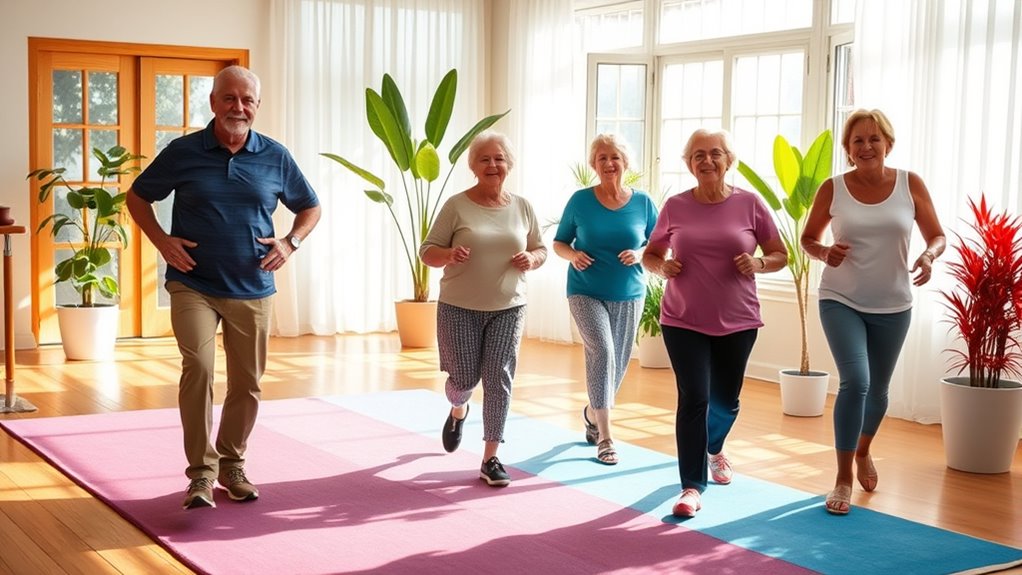
Indoor walking offers seniors a safe haven for exercise, free from the hazards of uneven terrain and unpredictable weather. This controlled environment helps keep you active while reducing the risk of falls and injuries. Furthermore, creating comfortable living spaces that are conducive to walking can significantly enhance your exercise experience. Additionally, being mindful of senior safety can further encourage a worry-free walking routine.
Regular indoor walking not only improves cardiovascular health but also enhances your mobility and increases endurance, contributing to better overall physical fitness. Studies show that seniors engaging in walking routines experience heightened strength and independence, which helps keep you capable of daily activities and maintaining a high quality of life. Incorporating mindfulness practices during your walks can further enhance self-awareness and emotional resilience, making it akin to the benefits gained from spiritual retreats that focus on holistic wellness. Moreover, participating in community events, such as themed breakfasts, can create additional motivation and social opportunities for seniors.
Plus, indoor walking can be done year-round, promoting consistent physical activity. It’s also a great way to boost your mood and energy levels, positively impacting your mental health and overall well-being.
Warm-Up Exercises to Prepare for Walking
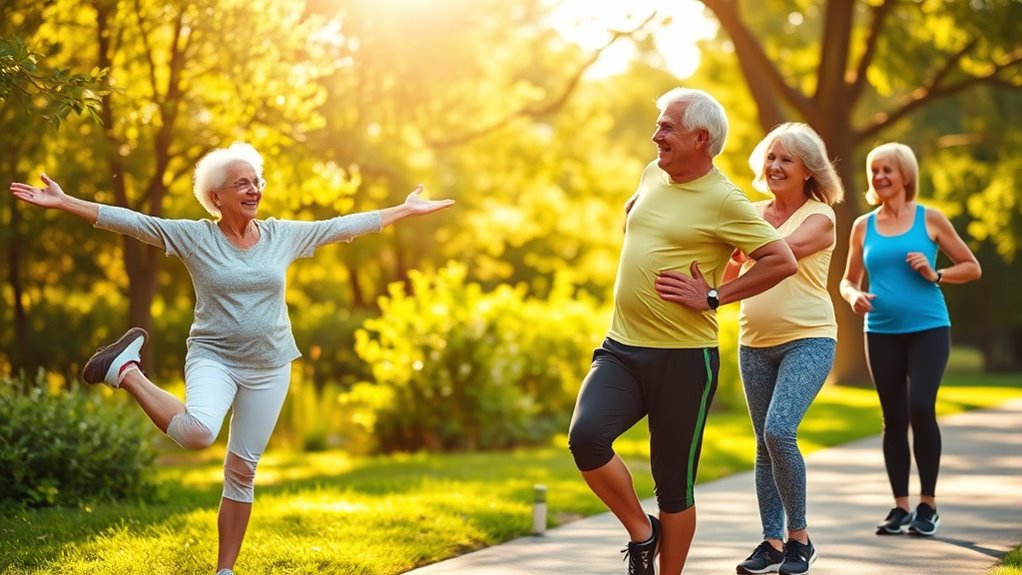
Before hitting the walking path, it’s essential to dedicate a few minutes to warm-up exercises. Start with marching in place to engage your core and improve posture, setting a solid foundation for your workout. Additionally, consider your air quality considerations as you exercise, as it can significantly impact your overall performance. Proper hydration is also crucial, as hydration and nutrition play a vital role in preventing fatigue during physical activity. Keeping an eye on signs of illness can also help you determine if you’re ready to start your walking routine.
Next, incorporate side steps to enhance lateral muscle engagement, which is important for balance and mobility. Don’t forget to include heel touches; they’ll boost your balance and coordination, making your walking safer. Engaging in these warm-up activities can help improve your credit score over time by promoting a healthier lifestyle, which can lead to lower healthcare costs.
Incorporate side steps and heel touches to enhance balance, coordination, and mobility for a safer walking experience.
Remember to maintain a comfortable pace during these warm-ups, allowing your heart rate to gradually increase. As you prepare your upper body and legs, you’ll also mentally gear up for the session ahead. Including healthy breakfast options in your routine can further enhance your energy levels for these physical activities.
These warm-ups not only promote physical readiness but also foster a positive mindset toward your exercise routine.
Engaging Main Workout Activities

Now that you’re warmed up and ready to go, engaging in main workout activities can elevate your walking routine.
Start with knee ups, shifting your weight from side to side to enhance core engagement and improve your balance.
Next, try forward and backward marching to activate your posterior chain muscles, strengthening your back and mobility.
Incorporate side steps with arm movements; place your hands on your hips while you do this to boost your heart rate and work on coordination.
Don’t forget to add bicep curls while walking for upper body strength.
Finally, include criss-cross arm movements during your marching for a fun way to challenge your coordination and cognitive functions.
Additionally, ensuring a safe exercise environment can help prevent injuries and enhance your overall workout experience.
Enjoy these activities to stay fit and energized!
Advanced Movements to Challenge Coordination
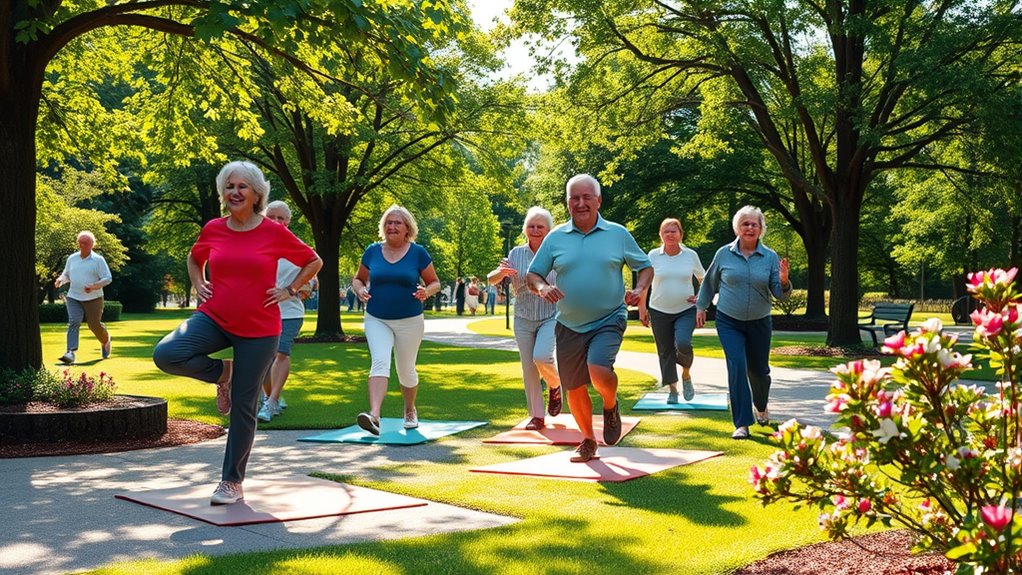
As you progress in your walking routine, incorporating advanced movements can greatly enhance your coordination and stability.
These exercises not only challenge your body but also keep your mind engaged. Here are three effective movements to try:
- Knee Ups with Arm Movements: As you walk forward, lift your knees while swinging your arms to engage multiple muscle groups. This helps improve overall physical health, which is crucial for maintaining mobility as you age. Additionally, engaging in continuous learning through new exercises can further stimulate your mind and body. Regular physical activity can also lead to improved mental health, enhancing your overall well-being.
- Bicep Curls While Walking: Carry light weights and perform curls to strengthen your upper body and challenge your coordination.
- Criss-Cross Arm Movements: During marching, cross your arms in front of your body, improving hand-eye coordination and cognitive function. Additionally, these activities can support emotional regulation, which is beneficial for maintaining overall mental health as you age.
Cool Down Techniques for Recovery

After your walking session, cooling down is essential for your recovery.
You’ll want to focus on stretching and breathing techniques to lower your heart rate and promote relaxation. Incorporating these practices not only helps prevent stiffness but also enhances your overall mobility. Additionally, maintaining consistent air quality in your environment, such as using air purifiers, can further support your recovery and energy levels. A clean environment with HEPA filters can significantly reduce allergens, which promotes better breathing and overall health. Investing in home security systems can also provide peace of mind, allowing you to focus on your wellness without worrying about safety concerns. Moreover, ensuring that your home is equipped with energy-efficient systems can contribute to a comfortable climate, aiding in your post-exercise recovery. Utilizing UV light technology in air purifiers can help eliminate germs, further enhancing the cleanliness of your living space.
Importance of Stretching
Here are a few key benefits:
- Improves Flexibility: Regular stretching helps increase your range of motion, important for maintaining independence, especially for seniors who may experience cognitive decline that affects their mobility. Additionally, stretching can help reduce muscle tension, which is crucial for seniors dealing with discomfort. Engaging in gentle stretching can also promote better sleep, allowing for more restorative rest.
- Aids Muscle Recovery: A cool-down stretching routine reduces soreness and stiffness, helping you bounce back faster.
- Boosts Balance: Targeted stretches like toe reaches and calf stretches strengthen your legs and help prevent falls.
Incorporating stretching into your routine also enhances blood circulation, supporting cardiovascular health and delivering crucial nutrients to your muscles. Additionally, practicing effective relaxation techniques can further improve your overall recovery experience.
Breathing Techniques Overview
Stretching is only one part of a well-rounded cool-down routine. Incorporating breathing techniques can greatly enhance your recovery after walking every day. By practicing rhythmic inhaling and exhaling, you’ll lower your heart rate and promote relaxation. Deep breathing increases oxygen flow to your muscles, helping to reduce soreness and improve overall stamina for future sessions. Focusing on your breath can also enhance mindfulness and reduce stress, promoting mental well-being.
Here’s a simple overview of breathing techniques:
| Technique | Benefits | Frequency |
|---|---|---|
| Deep Breathing | Increases oxygen flow | Every day |
| Rhythmic Breathing | Lowers heart rate | Every day |
| Breath Control | Enhances mindfulness | Every day |
| Diaphragmatic Breathing | Improves lung capacity | Every day |
| 4-7-8 Breathing | Reduces stress | Every day |
Encouragement and Motivation for Future Sessions
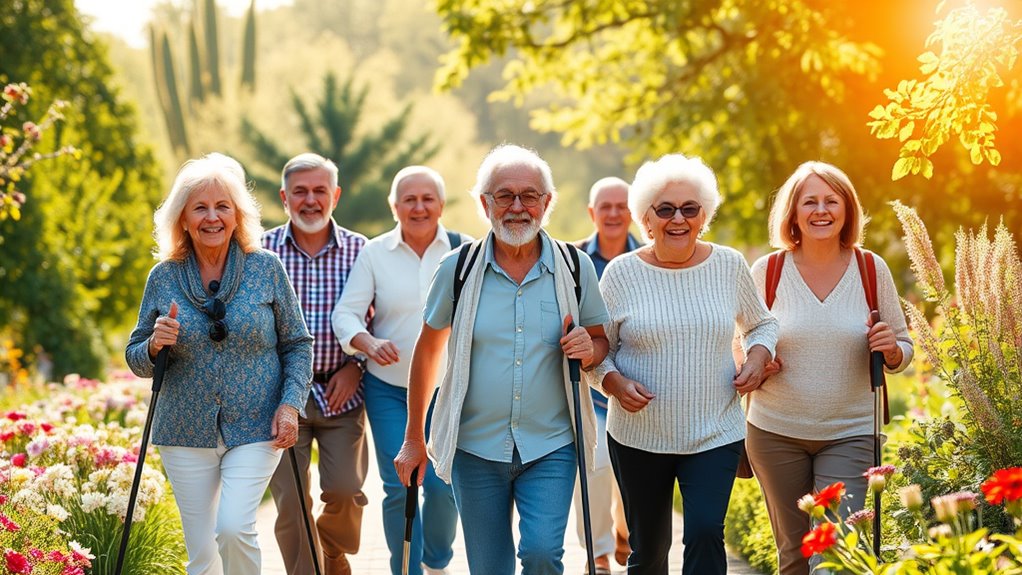
While it might be easy to overlook the importance of encouragement, staying motivated for your walking exercises can greatly enhance your overall experience.
Staying motivated during your walking exercises is crucial for enhancing your overall experience.
Here are three key strategies to keep you on track:
- Celebrate Small Wins: Acknowledge your efforts, no matter how small. Each step forward deserves recognition!
- Set Achievable Goals: Create realistic targets, and involve others for feedback. This fosters a sense of community and keeps you engaged.
- Incorporate Rewards: Add fun elements to your routine, like treating yourself after completing a week of walking. This makes exercise more enjoyable.
Frequently Asked Questions
What Is the Number 1 Exercise to Increase Balance in Seniors?
The number one exercise to boost balance in seniors is the single-leg stand.
You’ll find that it effectively challenges your stability while engaging your core muscles. Start by holding the position for 10-30 seconds and gradually increase the duration as you improve.
You can enhance the exercise by closing your eyes or standing on an unstable surface.
Regular practice won’t only improve your balance but also boost your confidence and independence in daily activities.
What Is the 6 6 6 Walking Rule?
The 6 6 6 Walking Rule suggests you aim to walk for at least 6 minutes, 6 times a day.
This adds up to a total of 36 minutes of walking daily.
It breaks down exercise into manageable chunks, so you won’t feel overwhelmed.
What Is a Good Walking Program for Seniors?
Think of a good walking program for seniors as a gentle breeze, revitalizing and invigorating.
Start with a 5-10 minute warm-up, like gentle marching, to get your body ready.
Aim for 150 minutes of brisk walking weekly to boost your heart health.
Mix in movements like knee ups and bicep curls for strength.
Finally, don’t forget to cool down with stretches to keep your muscles flexible and prevent soreness.
You’ll feel fantastic!
Can Walking Increase Energy Levels?
Yes, walking can definitely increase your energy levels.
When you walk, you improve blood circulation, which helps deliver more oxygen to your muscles and organs. This boosts your overall energy and reduces feelings of fatigue.
You’ll also release endorphins, which lift your mood and combat tiredness. Just 20 minutes of walking can make a noticeable difference, helping you feel more alert and energetic throughout the day.
Conclusion
Incorporating these walking exercises into your routine can truly enhance your mobility and energy levels, like charging up your smartphone for the day ahead. Remember, every step you take is a step toward better health. Keep challenging yourself with new movements, and don’t forget to warm up and cool down properly. Stay motivated by tracking your progress, and soon you’ll find that moving feels easier and more enjoyable than ever. Keep walking; your body will thank you!





